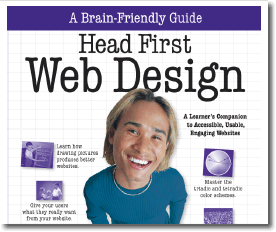 If I knew how cool it would be, I woulda looked into it much earlier. Or maybe now the timing is right.
If I knew how cool it would be, I woulda looked into it much earlier. Or maybe now the timing is right.
This particular book is perfect for somebody like me .. who already knows XHTML / CSS. That's how the book describes its target audience.
I love the Head First series of books, which incorporates recent research from cogntive science, neurobiology & educational psychology. Ive read other Head First books.
Deep-thinking lies at the root of their mantra. Sometimes their technques may seem a bit corny, but they really do work. The bottom-line is » you get it.
••• today's entry continues here below •••
The Head First style does add weight to a text .. maybe 50% more, perhaps even double. But you simply turn the pages faster. You also tend to muse the key concepts better. Because they repeat them using various cross-style learning techniques.
The Head First series is published by O'Reilly, who also publishes the Missing Manual series .. another excellent line. (Especially their one on » CSS.)
[ Chapter 8 is posted » here (PDF download) as a sample. Although 'Accessibility' is probably the least exciting chapter. ]
First lesson they teach » design for your readers, not for yourself (.. like I do). But I like my design. Simple yet effective. Minimalist color scheme .. tries to keep the focus on » content, which aims to simplify the complex.
And I dont know of any other sites which use that particular shade of blue-green that I use on the home page. I try to be unique, not just in content, either. I've also taken steps to maximize the usability of my home-page design.
Everything on the home page dumps to » Movable Type, a powerful (professional) Perl-based script that offers many cool & advanced features .. a "professional publishing platform".
As mentioned, the main concept behind the Head First line of books is » to get you to think more deeply. And yes, they have techniques to do just this. But I wont get in to them now .. tho using images is one. Because our brains think in pictures, not letters.
Web Design Basic Principles
Web Design is all about » communcation. You want to communicate something to your users/readers.
The process of building a web site is similar to that of building a house. You start with a blue-print .. before you touch a hammer (XHTML/CSS code).
First get your basic design down on paper (.. with pencil, no color). These sketches are called storyboards or comps (compositions).
Every web design project is comprised of the same 4 steps:
- PRE-PRODUCTION, which includes identifying the key sections of your site, and arranging them hierarchically. The most important part of pre-production is to determine your site's theme (such as simplifying complicated technical concepts), and develop a visual metaphor to support and enhance that theme.
- From pre-production, you will be able to deduce your site's NAVIGATON. The style of navigation you use (horizontal vs vertical, etc.) will be suggested by your site's design and layout.
- LAYOUT consists on translating your design on paper into its corresponding XHTML/CSS.
- WRITING good copy comes last. Writing for the web consists of copy that is SCANNABLE, which means it has descriptive headings, short paragraphs, key-words are bold or italics, and bulleted or numbered lists are used where appropriate.
Composing Entries | Local vs Web Interface
Composing entries locally with Dreamweaver -- which is generally considered the most powerful web design application -- is much easier/better than using even the best (web-based) blog/CMS (.. which I use).
Heck, even a basic text editor would be better than editing online (.. which I sometimes have to do). Web-based scripts are slow & clunky compared to working locally. Specially if you edit a lot.
Thats why I only export copy to Movable Type when done with Dreamweaver, or close.
For more along these lines, here's a Google search preconfigured for the query » head first web design book
